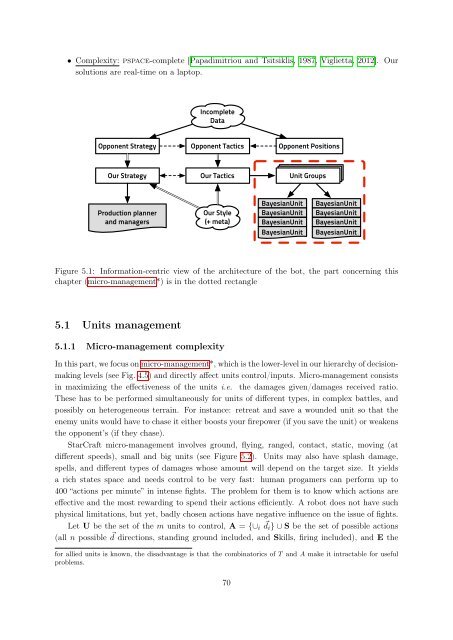Bayesian Programming and Learning for Multi-Player Video Games ...
Bayesian Programming and Learning for Multi-Player Video Games ...
Bayesian Programming and Learning for Multi-Player Video Games ...
You also want an ePaper? Increase the reach of your titles
YUMPU automatically turns print PDFs into web optimized ePapers that Google loves.
• Complexity: pspace-complete [Papadimitriou <strong>and</strong> Tsitsiklis, 1987, Viglietta, 2012]. Our<br />
solutions are real-time on a laptop.<br />
Opponent Strategy<br />
Incomplete<br />
Data<br />
Our Strategy Our Tactics<br />
Unit UnitGroups<br />
Groups<br />
Production planner<br />
<strong>and</strong> managers<br />
Opponent Tactics Opponent Positions<br />
Our Style<br />
(+ meta)<br />
<strong>Bayesian</strong>Unit<br />
<strong>Bayesian</strong>Unit<br />
<strong>Bayesian</strong>Unit<br />
<strong>Bayesian</strong>Unit<br />
<strong>Bayesian</strong>Unit<br />
<strong>Bayesian</strong>Unit<br />
<strong>Bayesian</strong>Unit<br />
<strong>Bayesian</strong>Unit<br />
Figure 5.1: In<strong>for</strong>mation-centric view of the architecture of the bot, the part concerning this<br />
chapter (micro-management*) is in the dotted rectangle<br />
5.1 Units management<br />
5.1.1 Micro-management complexity<br />
In this part, we focus on micro-management*, which is the lower-level in our hierarchy of decisionmaking<br />
levels (see Fig. 4.5) <strong>and</strong> directly affect units control/inputs. Micro-management consists<br />
in maximizing the effectiveness of the units i.e. the damages given/damages received ratio.<br />
These has to be per<strong>for</strong>med simultaneously <strong>for</strong> units of different types, in complex battles, <strong>and</strong><br />
possibly on heterogeneous terrain. For instance: retreat <strong>and</strong> save a wounded unit so that the<br />
enemy units would have to chase it either boosts your firepower (if you save the unit) or weakens<br />
the opponent’s (if they chase).<br />
StarCraft micro-management involves ground, flying, ranged, contact, static, moving (at<br />
different speeds), small <strong>and</strong> big units (see Figure 5.2). Units may also have splash damage,<br />
spells, <strong>and</strong> different types of damages whose amount will depend on the target size. It yields<br />
a rich states space <strong>and</strong> needs control to be very fast: human progamers can per<strong>for</strong>m up to<br />
400 “actions per minute” in intense fights. The problem <strong>for</strong> them is to know which actions are<br />
effective <strong>and</strong> the most rewarding to spend their actions efficiently. A robot does not have such<br />
physical limitations, but yet, badly chosen actions have negative influence on the issue of fights.<br />
Let U be the set of the m units to control, A = {∪i � di} ∪ S be the set of possible actions<br />
(all n possible � d directions, st<strong>and</strong>ing ground included, <strong>and</strong> Skills, firing included), <strong>and</strong> E the<br />
<strong>for</strong> allied units is known, the disadvantage is that the combinatorics of T <strong>and</strong> A make it intractable <strong>for</strong> useful<br />
problems.<br />
70


